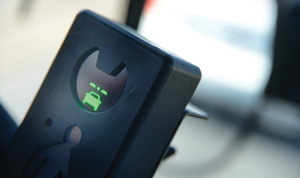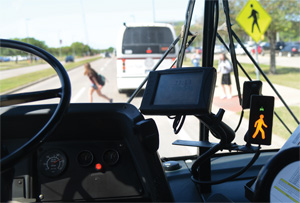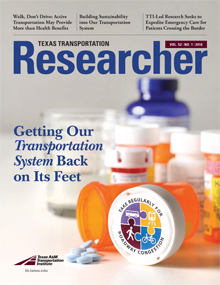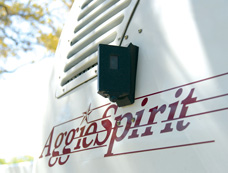From automated cruise control to Google self-driving cars to trucks platooning, the world of connected, automated and autonomous vehicles is rapidly evolving. A research project sponsored by the Texas Department of Transportation (TxDOT) and conducted by the Texas A&M Transportation Institute (TTI) is examining connected and automated vehicle applications to improve transit, bicyclist and pedestrian safety.
The project, Automated and Connected Vehicle Test Bed to Improve Transit, Bicycle, and Pedestrian Safety, is part of the TxDOT Innovative Projects Program. In 2014, TxDOT supplemented its Cooperative Research Program with the Innovative Projects Program to proactively address issues before they become problems and to explore applications of rapidly evolving technologies.
“The goal of this project is to reduce the number of crashes among transit vehicles, bicyclists and pedestrians,” says Research Project Manager Wade Odell of TxDOT’s Research and Technology Innovation Office. “Concerns found in the research include buses making turns at intersections or traveling in a straight line and negatively interacting with bicyclists and pedestrians, as well as distracted bicyclists and pedestrians not being aware of a transit vehicle.”
In the beginning of the project, TTI held meetings and workshops with modal stakeholders and conducted a technology scan to identify four near-term applications, three of which focus on collision avoidance with turning transit vehicles, straight-line travel and fixed objects. A fourth application is addressing bike-rack-on-buses safety.
In the longer term, the research team focused on the technologies associated with moving toward autonomous buses. The next step of the project is developing the concept of operations.
“In developing the concept of operations, we want to find out what technologies might be used, how you would operationalize those technologies, and what the test bed would look like,” says TTI Executive Associate Director Katie Turnbull. “During this phase, we discovered that the Mobileye/Rosco Vision Systems technology was available and that they were interested in testing their collision avoidance system in a campus setting. We thought it was a great opportunity to conduct a small pilot project on the Texas A&M University campus.”

Working in partnership with Texas A&M University Transportation Services, the Mobileye/Rosco Shield+™ collision-avoidance system was installed on one Texas A&M University bus that traverses the heart of campus, passing thousands of students daily.
“The system has four different cameras that are essentially aimed at the blind spots on the bus and where pedestrians and bicyclists are most likely to show up and be in harm’s way,” says Shawn Turner, head of TTI’s Mobility Division. “What’s special about this technology is that it is able to detect when there’s an object that’s moving that looks like a person or a cyclist.”
According to Turner, one of the big blind spots on a bus occurs while making a turn. Two of the cameras are positioned to eliminate those blind spots, thus creating a safer environment for the driver, pedestrians and bicyclists.
“The nature of a large passenger bus is that when it turns, it sweeps a big arc,” notes Turner. “In other words it takes up more space when turning. What happens is people tend to walk out and think of a car turning and not realize they can’t get as close to a bus.”
The system provides two types of warnings to the bus driver. A yellow light goes off when a pedestrian or bicyclist is detected within range of the bus, alerting the driver to proceed with caution. A red light and a buzzer go off when a pedestrian or bicyclist is very close to the bus, alerting the driver to stop to avoid a possible collision.
The research team is currently assessing the system and developing the overall concept of operations plan for the test bed. A roundtable forum was held on March 8 in College Station, Texas, with representatives from TxDOT, transit agencies, school districts, cities and other stakeholder groups. Participants had the opportunity to ride the bus around campus, see the system in operation, and hear from Mobileye and Rosco personnel on the system features.


